Imagine having to wear formal business attire everywhere on campus at all times! From about 1950 through 1989, Champlain College students, faculty and staff were required to do so in class, offices, the library, and even the dining hall. A new exhibition on the College’s dress code is now on view on the first floor of Miller Information Commons.
By the 1950s, a strict dress code policy was in place: Men wore collared shirts and neckties, and women wore skirts or dresses with heels. In cold weather, women were allowed to wear knee socks over their nylon stockings on their way to class, but they had to remove the socks when indoors. Men could not have beards or mustaches, and women had to wear their long hair up. Faculty were instructed to ask students who were inappropriately dressed to leave class. By 1964, details on the College’s dress code occupied two pages in the student handbook.

Champlain College Students in Class, October 1968, Champlain College Archives
Students began to protest in 1969, writing editorials in the campus newspaper, The Contemporary:
“The dress code is ridiculous. The way one dresses is one way to express oneself. And that’s a right.”
An advisory committee formed in 1970 studied the issue in depth and sent its recommendations to President C. Bader Brouilette, who relaxed the prohibition against women wearing pants — but only during cold weather between November and March. After more pushback, the policy was revised by 1973 to allow women to wear “tailored slacks:”
“The minimum standards of dress for men students will be trousers, dress or sport shirt, socks and shoes. Minimum standards for women students will be skirts and blouses or sweaters, dresses or tailored slacks.”

Champlain College student, April 1971, Champlain College Archives
The rules for longer hair styles and facial hair were relaxed by 1985, but students were reminded that “Unacceptable forms of attire are blue jeans, dungarees, dungaree skirts, painter’s pants, carpenter’s pants, T-shirts, sweat shirts, shorts, and bare feet.” Jeans, t-shirts, and shorts were not allowed until 1989.

Champlain College students practicing court stenography, c. 1985, Champlain College Archives
The College’s current policy on appearance standards is available here.
-Erica Donnis, Special Collections Director
